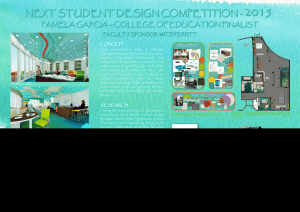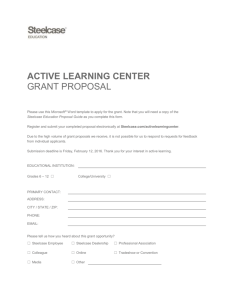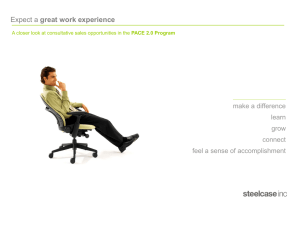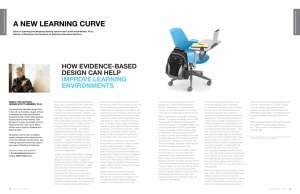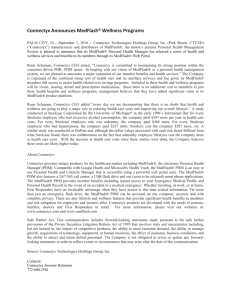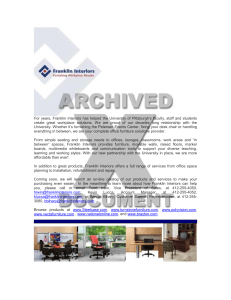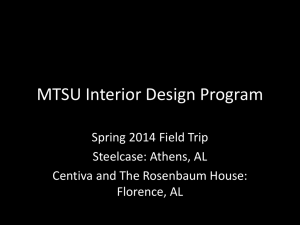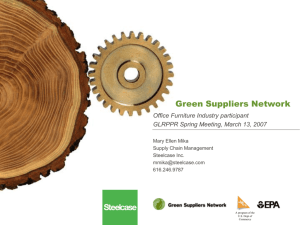Document 13624472
advertisement
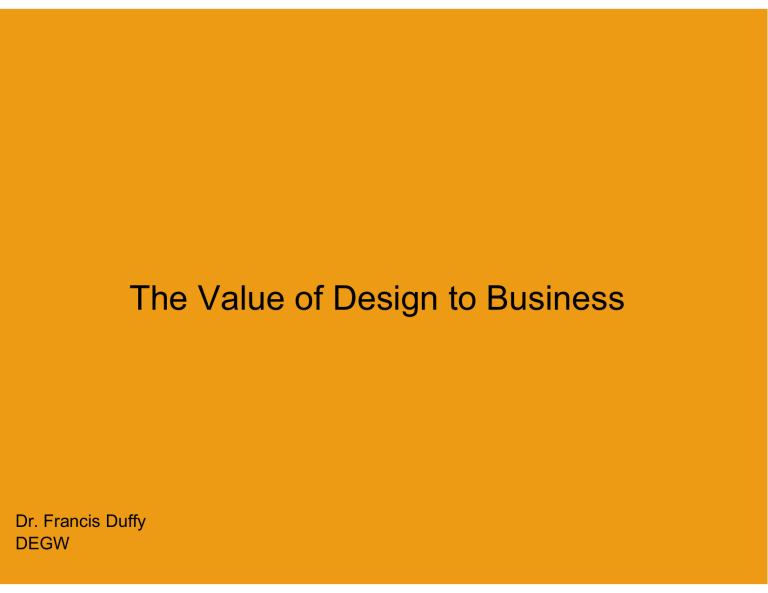
The Value of Design to Business Dr. Francis Duffy DEGW Steelcase 20 June 2002 Steelcase 20 June 2002 Steelcase 20 June 2002 Steelcase 20 June 2002 Steelcase 20 June 2002 Measuring Success Measuring Success Steelcase 20 June 2002 Precision and Impact are inversely Correlated the easiest things to measure are the least important Efficiency – how much can be achieved with less Effectiveness – what value can be added by imagination Expression – the messages that clients wish to convey Steelcase 20 June 2002 Measuring Success Steelcase 20 June 2002 Efficiency Measures are Direct: you get your $ back straight away Effectiveness and Expressiveness Measures are Indirect: depend upon the business context many intervening variables systemic relationships- people, process and place depend upon purposeful leadership the relationship must be managed! Measuring Success Steelcase 20 June 2002 Average costs per individual employee 15% other costs 10% technology costs 10% space costs 65% people costs (salaries and benefits) Measuring Success Increasing efficiency EFFECTIVENESS • Reducing cost • Using space to its full capacity • Achieving high occupancy levels • Making the most of space EFFICIENCY Steelcase 20 June 2002 EFFECTIVENESS Measuring Success EFFICIENCY Steelcase 20 June 2002 Increasing efficiency Increasing effectiveness • Reducing cost • Using space to its full capacity • Achieving high occupancy levels • Making the most of space • Adding value • Using space to its full potential • Enriching the range of settings • Making the most of people Measuring Success Steelcase 20 June 2002 EFFICIENCY making the most of space EFFECTIVENESS making the most of people EFFECTIVENESS Measuring Success EFFICIENCY Steelcase 20 June 2002 Increasing efficiency Increasing effectiveness • R educing cost Reducing • Using Spacespace used to its full full capacity capacity to • Achieving Maximum high levels occupancy levels of occupancy • Making the most of space your space • Increasing value • Using space to its full potential • Enriching the range of settings • Making the most of people Measuring Success Steelcase 20 June 2002 EXPRESSION - making the most of branding EFFICIENCY making the most of space EFFECTIVENESS making the most of people Steelcase 20 June 2002 Efficiency Measures Density of Occupation: sq ft (m2) per person % of shared workstations Cost of Occupation: $ per person per year sq ft (m2) filing per person Energy costs per sq ft (m2) per year Cost of Change: Churn Rate per year Average Cost of Churn per workstation Steelcase 20 June 2002 Effectiveness Measures Attraction and retention of staff: User priorities User satisfaction Staff turnover rates Stimulate interaction: Observations of interaction Use of meeting spaces Knowledge management Potential to accommodate change: Range of settings Steelcase 20 June 2002 Expression Measures Messages to staff: Perceptions of who is valued Contradictions/confusions/misunderstandings Messages to customers: Accessibility Speed of response Brand support Consistency Messages to shareholders: Leanness/return on capital/intellectual property Steelcase 20 June 2002 Steelcase 20 June 2002 Measuring Success Steelcase 20 June 2002 Three Caveats 1. Benchmarking is meaningless unless it is related directly to corporate goals 2. How is the process managed is as important as design and certainly as important as data 3. Data should be hot not cold imaginative hypotheses are critical Measuring Success The Conditions for Measurement Clear vision stating and sustaining project objectives Good data detailed information: people/place/process Integrated strategy balancing needs of people/place/process Communication of the results achieving the support of people at all levels Steelcase 20 June 2002 Four Propositions + a Conclusion Steelcase 20 June 2002 1: Design Innovation is impossible without Organizational Change – and vice versa 2: Physical Change and Change Management are inseparable 3: IT makes Place more not less important 4: Twentieth Century Planning, Real Estate and FM practices are dangerous Design today is substantially more important because it is becoming the catalyst of change Steelcase 20 June 2002
